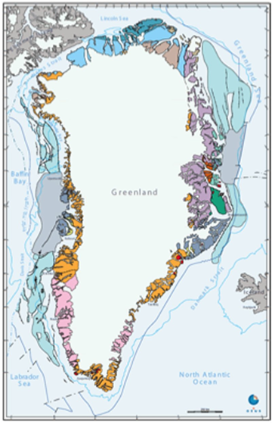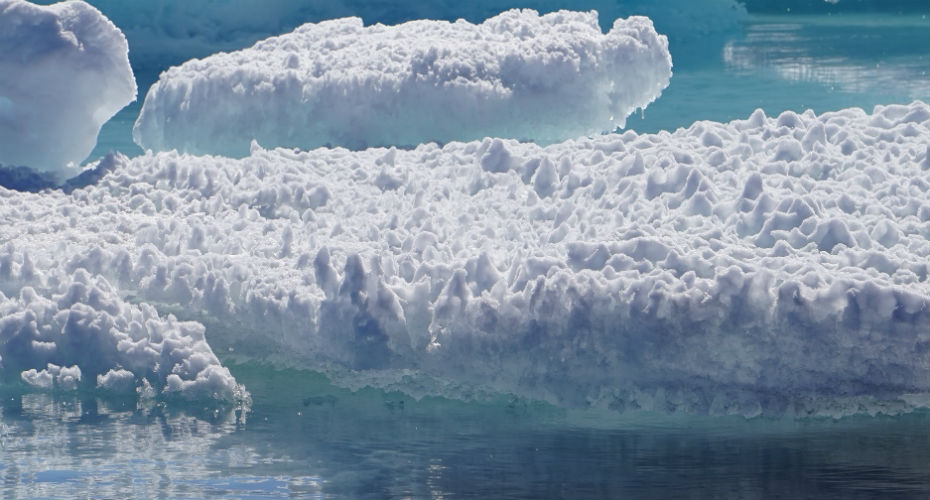
The geology of Greenland is geographically distinct allowing iceberg source terranes to be identified using our provenance approach

Visit this research group's sister website at the University of Southampton »
From icebergs to ice sheets: provenance of ice rafted sediments
One potential major consequence of anthropogenic global warming is sea level rise. Our understanding, however, of the likely magnitude of sea-level change over the coming century and beyond is poor because it is currently challenging to parameterize in numerical climate models the important contribution made by the melt history of continental ice sheets, such as the Greenland Ice Sheet, in response to a range of future warming scenarios.
Direct observations indicate that the Greenland Ice Sheet is currently losing mass at an accelerating rate and if it were to melt completely it would raise global sea-level by ~7 m, with profound consequences for countless populations that reside in coastal areas. If we are to have confidence in the ability of ice sheet models to predict the fate of the Greenland Ice Sheet over the coming century we need to accurately simulate its configuration for various past climate states. Such model outputs, however, need to be tested with geological evidence. We aim to do this by reconstructing ice sheet coverage in the geological past with a particular emphasis on Greenland Ice Sheet reduction during warmer than present time intervals. One important contribution to this problem is to compare the output of models with marine-core proxy evidence for past locations of iceberg calving.
This multi-disciplinary project involves Dr Ian Bailey at Camborne School of Mines in close collaboration with Prof Gavin Foster at the University of Southampton, Prof Craig Storey at University of Portsmouth and colleagues at the British Geological Survey, University of Sheffield, University of Bristol, Scott Polar Research Institute, University of Colorado Boulder, USA, and Lafayette, USA.
Key questions
- What are the key spatial differences in the geochemistry and geochronology of Greenland tectonic terranes that can be used to track the provenance of iceberg calving from the Greenland Ice Sheet?
- Does the provenance of Greenland IRD evolve from source to sink? A high-resolution spatial study of Kang Fjord sedimentation.
- Can we use marine-core proxy evidence to test models of modern and past warmer than present spatial patterns of Greenland iceberg calving?
- Can we marry geological evidence and model output to improve our understanding of the Pliocene-Quaternary history of the Greenland Ice Sheet?
- Can we improve models predictions for the future volume of the Greenland Ice Sheet in response to anthropogenic-driven climate warming?
Tools we use to achieve our aims
- The locations of Greenland Ice Sheet iceberg calving in both the modern and the geological past can be tracked by studying the provenance of individual sand-sized terrigenous grains (ice-rafted debris, IRD) deposited in marine sediments from the melting of debris-rich drifting icebergs.
- Greenland consists of a number of discrete geologic terranes with unique geochemical (e.g. Pb, Nd, Sr isotope composition) and/or chronological (Ar-Ar age) characteristics, which are imparted upon IRD accumulating in proximal sediments shed from the Greenland Ice Sheet.
- We can then use the spatial pattern of IRD provenance established from marine cores to: 1) reconstruct past locations of iceberg calving from Greenland in, e.g. warmer than present Pliocene and Quaternary interglacials and 2) test the output of state-of-the-art ice sheet models. We will achieve the latter by forcing an iceberg trajectory model that simulates spatial iceberg drift and IRD sedimentation with the ice-sheet model predictions of Greenland iceberg calving rates and locations.
- White, L.F., Bailey, I. et al, 2016. Tracking the provenance of Greenland sourced, Holocene aged, individual sand-sized ice-rafted debris using the Pb-isotope compositions of feldspars and 40Ar/39Ar ages of hornblendes. Earth and Planetary Science Letters 433, 192–203.
- Bailey, I., et al, 2013. An alternative suggestion for the Pliocene onset of major northern hemisphere glaciation based the geochemical provenance of North Atlantic Ocean ice-rafted debris. Quaternary Science Reviews 75C, 181–194.
- Bailey, I., et al, 2012. The flux and provenance of ice-rafted debris in the earliest Pleistocene sub-polar North Atlantic Ocean comparable to that of the last glacial maximum, Earth and Planetary Science Letters 341-344, 222-233.
